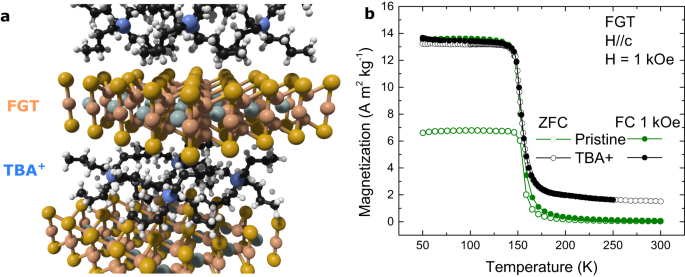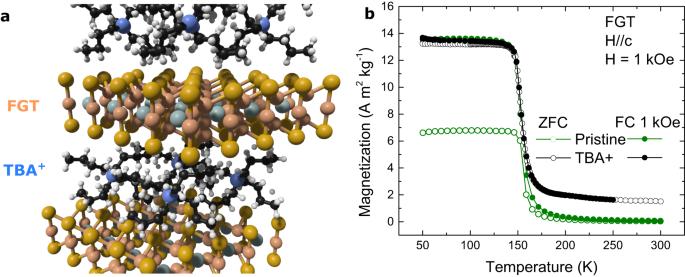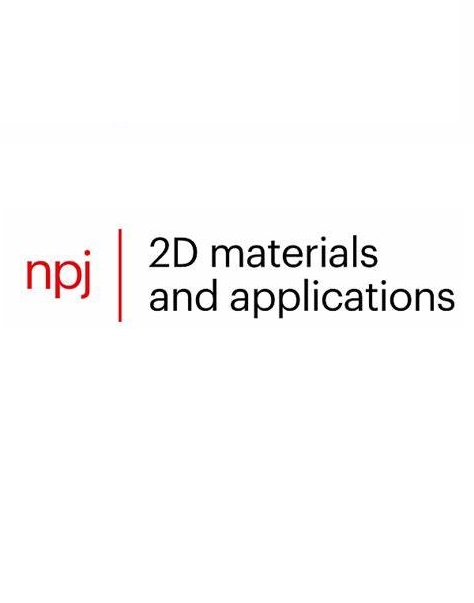插层准二维 Fe3-xGeTe2 范德华磁体的磁特性
IF 9.1
2区 材料科学
Q1 MATERIALS SCIENCE, MULTIDISCIPLINARY
引用次数: 0
摘要
在几种众所周知的过渡金属基化合物中,可裂解范德华(vdW)Fe3-xGeTe2(FGT)磁体因其强大的垂直磁各向异性、可观的居里温度(TC ~154 K)以及在低维极限下保持的多功能磁性,成为二维(2D)磁性器件的有力候选材料。虽然居里温度对于实际应用来说仍然太低,但人们已经成功地通过压力、辐照和掺杂等外部驱动力来提高居里温度。在此,我们通过实验证明了普通四丁基铵阳离子(TBA+)电化学插层诱导的室温(RT)铁磁相进入准二维 FGT。我们获得了高达 350 K 的居里温度,并且插层化合物具有化学和物理稳定性。随温度变化的拉曼测量结果与 vdW 校正的 ab initio 计算相结合,表明插层时的电荷转移(电子掺杂)可导致 RT 铁磁性的观察。这项研究表明,分子插层是以廉价和可靠的方式实现高温 vdW 磁体的可行途径,并有可能扩展到双层和少层 vdW 磁体。本文章由计算机程序翻译,如有差异,请以英文原文为准。


Magnetic properties of intercalated quasi-2D Fe3-xGeTe2 van der Waals magnet
Among several well-known transition metal-based compounds, cleavable van der Waals (vdW) Fe3-xGeTe2 (FGT) magnet is a strong candidate for use in two-dimensional (2D) magnetic devices due to its strong perpendicular magnetic anisotropy, sizeable Curie temperature (TC ~154 K), and versatile magnetic character that is retained in the low-dimensional limit. While the TC remains far too low for practical applications, there has been a successful push toward improving it via external driving forces such as pressure, irradiation, and doping. Here we present experimental evidence of a room temperature (RT) ferromagnetic phase induced by the electrochemical intercalation of common tetrabutylammonium cations (TBA+) into quasi-2D FGT. We obtained Curie temperatures as high as 350 K with chemical and physical stability of the intercalated compound. The temperature-dependent Raman measurements, in combination with vdW-corrected ab initio calculations, suggest that charge transfer (electron doping) upon intercalation could lead to the observation of RT ferromagnetism. This work demonstrates that molecular intercalation is a viable route in realizing high-temperature vdW magnets in an inexpensive and reliable manner, and has the potential to be extended to bilayer and few-layer vdW magnets.
求助全文
通过发布文献求助,成功后即可免费获取论文全文。
去求助
来源期刊

npj 2D Materials and Applications
Engineering-Mechanics of Materials
CiteScore
14.50
自引率
2.10%
发文量
80
审稿时长
15 weeks
期刊介绍:
npj 2D Materials and Applications publishes papers on the fundamental behavior, synthesis, properties and applications of existing and emerging 2D materials. By selecting papers with the potential for impact, the journal aims to facilitate the transfer of the research of 2D materials into wide-ranging applications.
 求助内容:
求助内容: 应助结果提醒方式:
应助结果提醒方式:


